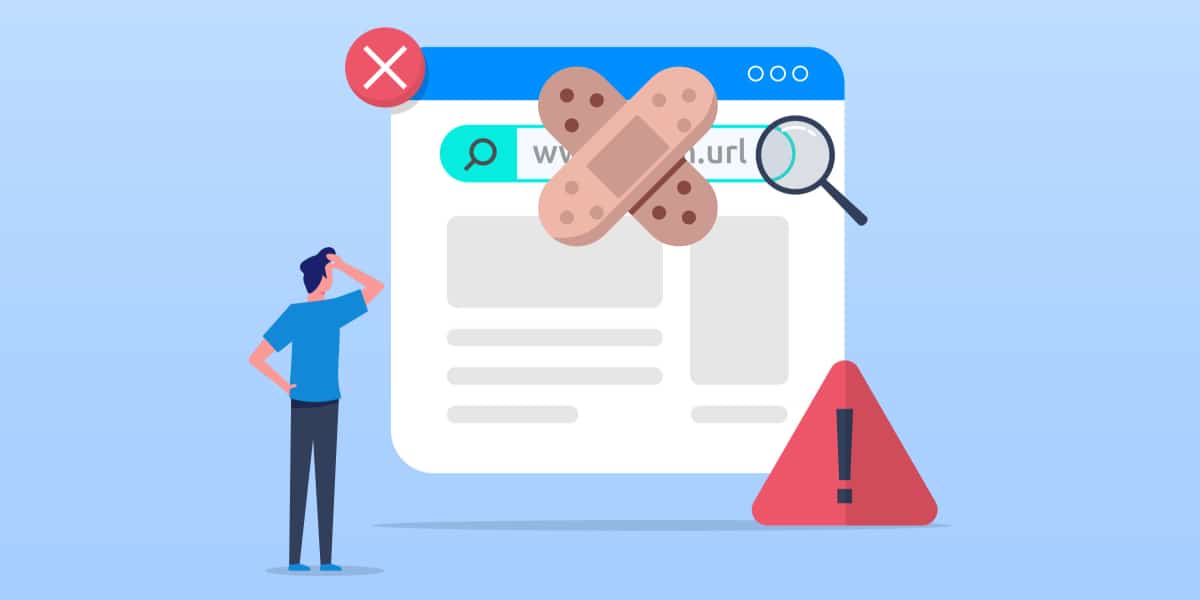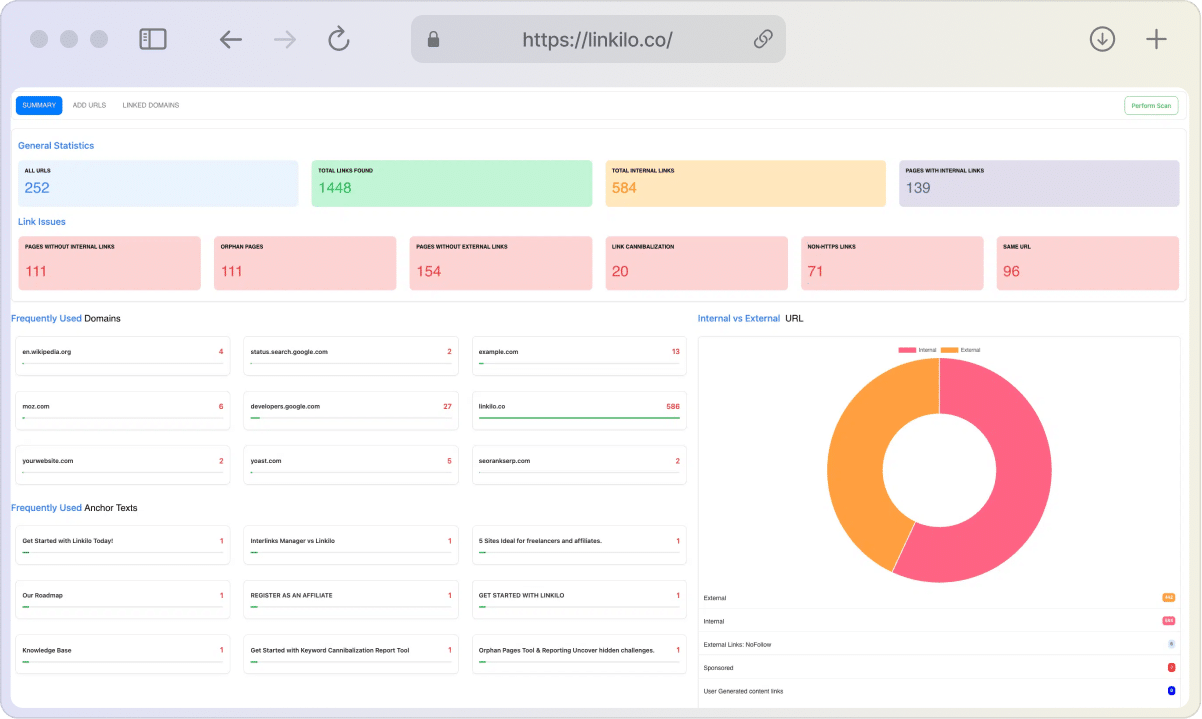SEO is a rapidly evolving field that demands constant vigilance to keep up with the latest trends and algorithm updates. SEOing must be proactive to deliver substantial results to their clients.
Even the most experienced SEO experts can sometimes overlook crucial aspects, leading to less-than-optimal outcomes. Here are 38 common mistakes you must avoid and how to rectify them.
1. Not Focusing on the Right Keywords
Choosing the wrong keywords can undermine your entire SEO strategy. It’s not just about targeting high-volume keywords; relevance and user intent are equally important. For instance, targeting broad, high-volume keywords may bring in traffic but not necessarily the right audience.
Avoid this mistake by:
- Doing thorough keyword research to understand what your target audience is actually searching for.
- Use tools like Google Keyword Planner or Ahrefs to find relevant keywords with decent search volume and manageable competition.
- Consider long-tail keywords. They might have less search volume, but they’re usually less competitive and have higher conversion rates because they’re more specific.
2. Not Optimizing Meta Descriptions and Title Tags
Meta descriptions and title tags play a crucial role in influencing click-through rates from search engine results pages (SERPs). A well-crafted title tag and meta description can set your content apart from the rest.
Avoid this mistake by:
- Write unique, compelling meta descriptions and title tags for each page, highlighting the main value propositions.
- Include your target keywords, but avoid keyword stuffing.
- Keep within the optimal length – under 60 characters for title tags and under 160 characters for meta descriptions.
3. Ignoring Mobile Users
Mobile-first indexing means that Google predominantly uses the mobile version of the content for indexing and ranking. If your site isn’t mobile-friendly, you’re potentially missing out on a significant amount of traffic.
Avoid this mistake by:
- Implementing responsive design to ensure your website looks good and functions well on all device sizes.
- Use Google’s Mobile-Friendly Test tool to see if your pages are well optimized for mobile devices.
- Check your site on various devices to ensure a seamless user experience.
4. Slow Page Loading Speeds
A slow website can lead to higher bounce rates and lower rankings. Google considers page speed a ranking factor.
Avoid this mistake by:
- Checking your website’s loading speed using tools like Google’s PageSpeed Insights.
- Optimize images, leverage browser caching, reduce server response time, and minify CSS, JavaScript, and HTML.
- Consider using a Content Delivery Network (CDN) to speed up delivery of your site’s content.
5. Not Having an SSL Certificate
An SSL certificate is crucial for maintaining your site’s security and gaining your users’ trust. Google also prefers secure sites, so not having one can impact your rankings.
Avoid this mistake by:
- Obtaining an SSL certificate for your website.
- Ensuring all pages on your site are accessible via HTTPS.
6. Ignoring Local SEO
Local SEO is an essential aspect of a successful SEO strategy, especially for businesses serving specific geographical areas.
Avoid this mistake by:
- Claiming and optimizing your Google My Business profile.
- Incorporating local keywords in your SEO strategy.
- Gathering positive customer reviews to improve your online reputation.
7. Not Using Header Tags Properly
Header tags (H1, H2, H3, etc.) help search engines understand your content’s structure and hierarchy, which can positively impact SEO.
Avoid this mistake by:
- Using only one H1 tag per page, which should contain the page’s main idea.
- Use subheadings (H2, H3, etc.) to break down your content, making it easier to read.
8. Overlooking the Importance of Backlinks
Backlinks are a vital ranking factor. However, it’s about quality, not quantity. A few backlinks from high-authority websites are better than numerous ones from low-quality sites.
Avoid this mistake by:
- Creating high-quality, unique content that others want to link to.
- Reaching out to reputable sites in your industry for guest posting opportunities.
- Regularly check your backlink profile and disavow any harmful links.
9. Not Conducting Regular SEO Audits
Regular SEO audits are crucial for identifying potential issues that could harm your site’s performance and visibility.
Avoid this mistake by:
- Conducting comprehensive SEO audits at least twice a year.
- Use tools like SEMrush or Ahrefs to assist in your auditing process.
- Addressing issues promptly to prevent any negative impact on your SEO efforts.
10. Ignoring User Experience (UX)
Google’s algorithms are increasingly focusing on user experience. A positive UX can lead to better user engagement, retention, and conversions.
Avoid this mistake by:
- Making your site easy to navigate with a clear, intuitive layout.
- Ensuring your site loads quickly and is mobile-friendly.
- Providing high-quality, relevant content that meets your users’ needs.
11. Not Using Google Analytics and Google Search Console
Not using analytics tools like Google Analytics can keep you in the dark about how your SEO strategies are performing. These tools provide crucial insights into your website’s traffic, user behavior, and more, helping you make informed decisions about where to focus your SEO efforts.
These are free tools provided by Google that can provide valuable insights into your website’s performance and search traffic.
Avoid this mistake by:
- Setting up Google Analytics and Google Search Console.
- Regularly reviewing the data and reports for insights on site performance and user behavior.
12. Ignoring Social Media
Social signals can indirectly impact your SEO. While they don’t directly contribute to your rankings, they can enhance your brand visibility and drive traffic to your site.
Avoid this mistake by:
- Maintain an active presence on relevant social media platforms.
- Encourage social sharing of your content.
13. Not Updating Old Content
Old, outdated content can harm your site’s credibility. Regularly updating your content keeps it fresh and relevant, which search engines prefer.
Unique, quality content is the cornerstone of SEO. It improves your ranking and increases user engagement. More than that, it establishes your site as an authoritative resource, leading to more shares, more backlinks, and a better reputation.
Avoid this mistake by:
- Audit your existing content and update it with new information.
- Remove or rewrite outdated sections.
14. Using Duplicate Content
Duplicate content can harm your rankings. Ensure each page on your site has unique, high-quality content.
Avoid this mistake by:
- Regularly checking your site for duplicate content.
- Use tools like Copyscape to identify duplicate content.
- Rewrite or remove duplicate content and ensure each page is unique.
15. Neglecting Content Depth and Quality
Superficial content that lacks depth can lead to poor engagement and lower rankings.
How to avoid this mistake:
- Focus on creating comprehensive, well-researched content.
- Ensure your content provides real value and answers user queries thoroughly.
16. Over-Optimizing Content
Over-optimization can lead to penalties from Google. It’s important to balance keyword usage with writing high-quality, valuable content for your audience.
Avoid this mistake by:
- Writing for your audience first, search engines second.
- Using keywords naturally within your content.
17. Ignoring Structured Data (Schema Markup)
Structured data helps search engines understand your content better and can lead to rich snippets, enhancing your visibility in SERPs.
Avoid this mistake by:
- Implement schema markup for relevant content.
- Use tools like Google’s Structured Data Testing Tool to ensure accuracy.
18. Poor Internal Linking
One frequently overlooked SEO strategy is the effective use of internal links. These links, which direct users from one page on your site to another, help search engines understand the structure and hierarchy of your website. A well-planned internal linking structure can distribute page authority throughout your site and enhance user navigation.
Avoid this mistake by:
- Include relevant internal links in your content.
- Regularly check for and fix broken internal links.
19. Focusing Only on Ranking
Ranking is important, but it’s not the end goal. The main goal should be to attract the right audience and convert them.
Avoid this mistake by:
- Prioritize your audience’s needs and create valuable content.
- Track meaningful metrics like conversions, time on site, and user engagement.
20. Not Using SEO Tools
There are numerous SEO tools available that can help you analyze your website, competitors, and market, making your SEO efforts more effective and less time-consuming.
Avoid this mistake by:
- Leveraging tools like Google Analytics, SEMrush, Ahrefs, etc.
- Regularly monitoring your performance and tweaking your strategy based on data.
21. Not Building a Community
Building a community around your brand can lead to higher user engagement and more shares, backlinks, and visibility.
Avoid this mistake by:
- Actively engaging with your audience on social media, blog comments, etc.
- Creating valuable, shareable content that resonates with your audience.
22. Writing for Search Engines, Not Humans
While SEO is crucial, your primary focus should be on creating content that adds value to your human readers.
Avoid this mistake by:
- Writing in a natural, engaging style.
- Delivering high-quality, useful content that satisfies user intent.
23. Not Considering Voice Search
As the popularity of voice assistants like Alexa and Siri continues to grow, optimizing for voice search is becoming more important.
Avoid this mistake by:
- Incorporating conversational keywords into your content.
- Making sure your website loads quickly and is mobile-friendly.
24. Underestimating the Value of an XML Sitemap
An XML sitemap is crucial for helping search engines navigate your site and index your pages more efficiently. A common mistake is failing to create and maintain an up-to-date XML sitemap.
Avoid this mistake by:
- Creating an XML sitemap and regularly updating it.
- Submitting your XML sitemap to search engines to improve the crawling of your site.
25. Using Irrelevant Keywords
Using irrelevant keywords, especially high-volume ones, may seem beneficial, but it can do more harm than good. These keywords may not align with your audience’s search intent, leading to lower conversion rates.
Avoid this mistake by:
- Researching and understanding your audience’s search intent.
- Using keywords relevant to your products or services.
26. Neglecting SEO-friendly URL Structures
URLs should be logical, clean, and comprehensible for both users and search engines. Complicated URLs that contain irrelevant characters or don’t reflect the page content can harm your SEO efforts.
Avoid this mistake by:
- Ensuring that your URLs are well-structured and easily readable.
- Making sure that URLs accurately reflect the content of the pages.
27. Relying Solely on Organic SEO
While organic SEO should be the primary focus, it’s beneficial to supplement these efforts with paid search campaigns, especially in competitive markets where ranking organically takes time.
Avoid this mistake by:
- Using a combination of organic and paid SEO strategies.
- Regularly monitoring and adjusting your strategies based on performance.
28. Overlooking Broken Links
Broken links create a poor user experience and can negatively impact your SEO. Regularly checking your website for broken links is an important part of website maintenance.
Avoid this mistake by:
- Regularly auditing your website for broken links.
- Promptly fixing or removing any broken links you find.
29. Poor Site Architecture
Poor site architecture can confuse users and search engine crawlers, which can affect user experience and your SEO performance negatively.
Avoid this mistake by:
- Planning and implementing a logical, easy-to-follow site structure.
- Regularly reviewing and improving your site architecture as necessary.
30. Inefficient Use of Robots.txt
The robots.txt file tells search engine bots which pages or sections of your site to crawl or not to crawl. Misuse of this file can lead to important pages being ignored or unnecessary pages being indexed.
Avoid this mistake by:
- Using the robots.txt file properly to guide search engine crawlers.
- Regularly reviewing and updating your robots.txt file as needed.
31. Ignoring User Engagement Metrics
User engagement metrics, such as time on site, pages per session, and bounce rate, provide valuable insights into user interaction. High user engagement often correlates with higher rankings, reflecting valuable and relevant content.
Avoid this mistake by:
- Regularly monitoring user engagement metrics.
- Making improvements based on these insights to enhance user experience and boost rankings.
32. Overlooking Image Optimization
Large, unoptimized images can dramatically slow down your site, negatively impacting user experience and SEO.
Avoid this mistake by:
- Using appropriate file formats for your images.
- Compressing images to reduce file size without losing quality.
- Using descriptive file names and alt text for your images.
33. Not Investing in Quality Content
Quality content is a powerful SEO tool. It not only helps in ranking but also engages users, encouraging them to stay longer and interact more with your content.
Avoid this mistake by:
- Consistently creating high-quality, relevant content that adds value to your users.
- Regularly updating existing content to maintain its relevance and accuracy.
34. Not Monitoring Your Competitors
Monitoring competitors’ SEO strategies can provide valuable insights. You can learn from their successes and failures and adapt your strategies accordingly.
Avoid this mistake by:
- Keeping an eye on your competitors’ SEO activities.
- Learning from their successes and failures to enhance your own strategies.
35. Not Making Use of Semantic SEO
Semantic SEO focuses on optimizing for the intent behind a search, rather than just focusing on the specific keywords used. Neglecting this aspect can lead to lower-quality traffic and a decrease in user satisfaction.
Avoid this mistake by:
- Understanding and optimizing for user intent in your SEO practices.
- Creating content that answers user queries effectively and comprehensively.
36. Not Keeping Up With SEO Trends
The world of SEO is dynamic and constantly evolving. Failing to keep up with the latest trends and updates can render your strategies outdated and ineffective.
Avoid this mistake by:
- Regularly researching the latest SEO trends and updates.
- Adapting your strategies to accommodate these changes.
37. Using Automated SEO Tactics
While automation can assist with certain aspects of SEO, over-reliance on it can result in impersonal content and potentially harmful practices such as keyword stuffing.
Avoid this mistake by:
- Balancing automated SEO practices with personalized strategies.
- Ensuring that your automated tactics do not lead to over-optimization or unethical SEO practices.
38. Not Learning from Your Mistakes
Mistakes are part of the SEO journey. Not learning from them and making the same mistakes over and over can hold back your SEO efforts.
Avoid this mistake by:
- Regularly analyzing your SEO performance to identify weaknesses and areas for improvement.
- Implementing changes based on your analysis and monitoring the results.
39. Ignoring Content Freshness
Search engines favor fresh content. If you neglect to update your content regularly, it can become outdated and less relevant.
How to avoid this mistake:
- Regularly update your content with new information and insights.
- Review and refresh older posts to ensure they remain current and valuable.
40. Neglecting Site Security Beyond SSL
While having an SSL certificate is crucial, overall site security is equally important. Vulnerabilities can lead to hacks, affecting your site’s performance and reputation.
How to avoid this mistake:
- Regularly update your site’s software and plugins.
- Implement security measures like firewalls and regular backups.
41. Poor URL Canonicalization
Having multiple URLs for the same content can confuse search engines, diluting your ranking power.
How to avoid this mistake:
- Use canonical tags to indicate the preferred URL.
- Ensure your site redirects to a single URL format (e.g., https://www.example.com).
42. Neglecting Page Experience Signals
Google’s Core Web Vitals assess elements like loading performance, interactivity, and visual stability. Ignoring these can hurt your SEO.
How to avoid this mistake:
- Monitor and improve your site’s Core Web Vitals using tools like Google Search Console.
- Focus on enhancing load times, responsiveness, and content layout shifts.
43. Ignoring International SEO Best Practices
If you have a global audience, not optimizing for different regions and languages can limit your reach.
How to avoid this mistake:
- Use hreflang tags to specify language and regional targeting.
- Create localized content for different regions.
44. Not Considering User Search Intent
Focusing solely on keywords without understanding user intent can lead to high bounce rates and low engagement.
How to avoid this mistake:
- Analyze search intent behind your target keywords.
- Create content that addresses the specific needs and queries of your audience.
45. Overlooking Image Alt Text
Alt text helps search engines understand your images and improves accessibility for users with disabilities.
How to avoid this mistake:
- Provide descriptive, keyword-rich alt text for all images.
- Ensure alt text accurately represents the content of the image.
46. Lacking a Clear Content Strategy
Publishing content without a cohesive strategy can lead to inconsistent quality and missed opportunities for engagement.
How to avoid this mistake:
- Develop a content calendar and strategy aligned with your SEO goals.
- Focus on creating high-quality, targeted content that addresses your audience’s needs.
47. Ignoring Off-Page SEO Factors
While on-page SEO is critical, off-page factors like social signals and brand mentions also impact your ranking.
How to avoid this mistake:
- Engage in social media marketing to increase brand visibility.
- Foster relationships with influencers and industry leaders for brand mentions and backlinks.
48. Underestimating the Importance of Analytics
Without proper tracking and analysis, you can’t measure the success of your SEO efforts or identify areas for improvement.
How to avoid this mistake:
- Set up and regularly review analytics tools like Google Analytics.
- Use insights from analytics to refine and adjust your SEO strategies.
49. Failing to Optimize for Featured Snippets
Featured snippets can significantly increase your visibility and click-through rates. Not targeting them can be a missed opportunity.
How to avoid this mistake:
- Identify queries that trigger featured snippets and optimize your content to answer those questions clearly and concisely.
- Use structured data and lists to improve your chances of being featured.
Conclusion
In conclusion, SEO is an intricate, dynamic field that demands a comprehensive, well-rounded approach. From keyword research and user experience to website architecture and content quality, every facet contributes to your online visibility. Avoiding the 38 common SEO mistakes outlined in this article is crucial to keeping your website at the top of search engine results.
But remember, the world of SEO doesn’t stand still. It constantly evolves, shaped by changing algorithms, emerging technologies, and shifting user behaviors. Therefore, staying informed about the latest trends and updates and adapting your strategies accordingly is non-negotiable.
Don’t be daunted by the breadth and depth of SEO. View it as an ongoing journey of learning, experimentation, and adaptation. Each mistake avoided, and every improvement made, however small, brings you one step closer to a robust online presence, increased organic traffic, and ultimately, business success.
Keep in mind that while SEO is a powerful tool in your digital marketing arsenal, it’s not a quick fix. It requires time, patience, and persistence. So, stay the course, keep refining your strategies, and the results will follow.
Finally, never lose sight of the fact that at the heart of all your SEO efforts are your users. Prioritize creating high-quality, valuable, and relevant content that meets their needs and exceeds their expectations. Because when you serve your users well, you also serve your SEO goals.




